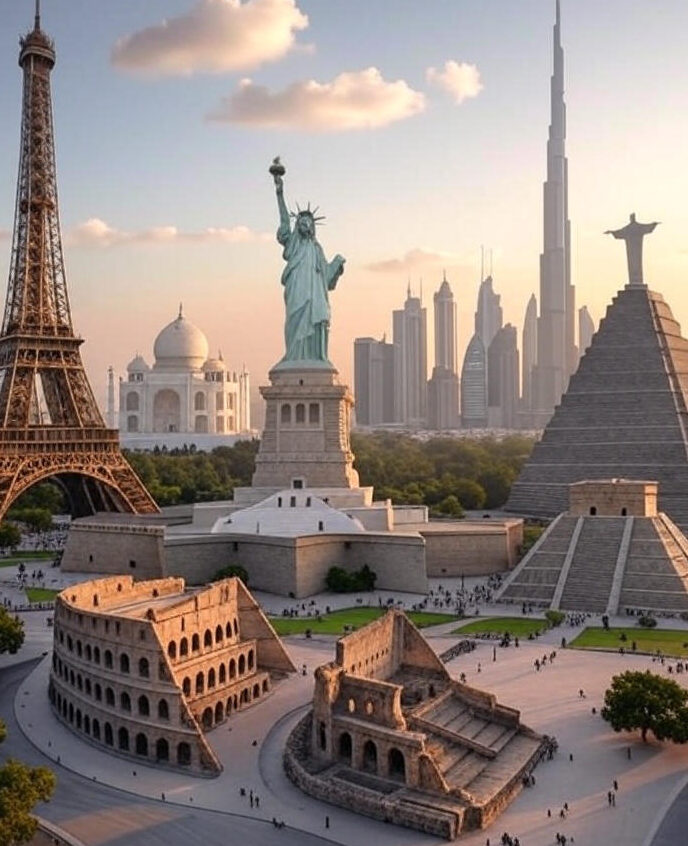The concept of the Seven Wonders refers to lists of remarkable landmarks celebrated for their historical, cultural, architectural, or natural significance. The most well-known lists are the Seven Wonders of the Ancient World and the New Seven Wonders of the World, but other lists, such as the Seven Natural Wonders and Seven Wonders of the Modern World, also exist. The “Seven Wonders of the World” are iconic monuments recognized for their architectural brilliance, historical significance, and cultural impact. The concept dates back to ancient Greek historians who listed the most extraordinary man-made structures of their time.
1. Seven Wonders of the Ancient World
The Seven Wonders of the Ancient World is a list of extraordinary constructions from antiquity, primarily from the Mediterranean and Near Eastern regions, compiled by ancient Greek historians and scholars like Herodotus (5th century BCE) and later writers such as Philo of Byzantium and Antipater of Sidon. These wonders were celebrated for their architectural grandeur, cultural significance, and engineering achievements.
List of the Seven Wonders of the Ancient World
- Great Pyramid of Giza (Giza, Egypt)
- Description: Built around 2630 BCE for Pharaoh Khufu, this is the largest of the three pyramids in Giza and the oldest of the ancient wonders. It served as a tomb and is renowned for its massive scale (originally 146.5 meters tall) and precise engineering.
- Status: The only ancient wonder still standing, largely intact.
- Significance: A testament to ancient Egyptian engineering, it was the tallest man-made structure for over 3,800 years.
2. Hanging Gardens of Babylon (Babylon, modern-day Iraq)
- Description: Allegedly built by King Nebuchadnezzar II in the 6th century BCE for his wife, these gardens were described as terraced, lush gardens with advanced irrigation systems, possibly using water from the Euphrates River.
- Status: Likely mythical or destroyed; no definitive archaeological evidence exists.
- Significance: Symbolized the opulence of Babylon and the ingenuity of its irrigation systems.
3.Temple of Artemis at Ephesus (Ephesus, modern-day Turkey)
- Description: A grand temple dedicated to the Greek goddess Artemis, constructed around 550 BCE. It was famed for its size (115 meters long) and ornate design, with 127 columns.
- Status: Destroyed by arson in 356 BCE and later floods; only fragments remain.
- Significance: A pinnacle of Greek architecture and religious devotion.
4. Statue of Zeus at Olympia (Olympia, Greece)
- Description: A 12-meter-tall statue of Zeus, created by sculptor Phidias around 435 BCE, housed in a temple at the site of the ancient Olympic Games.
- Status: Destroyed, possibly in the 5th century CE; exact cause unknown.
- Significance: Represented the religious and cultural importance of the Olympian gods.
5. Mausoleum at Halicarnassus (Bodrum, modern-day Turkey)
- Description: A grand tomb built around 350 BCE for King Mausolus, designed by Greek architects. It stood about 45 meters tall and was adorned with intricate sculptures.
- Status: Destroyed by earthquakes between the 12th and 15th centuries; some sculptures survive in museums.
- Significance: Gave rise to the term “mausoleum” for grand tombs.
6.Colossus of Rhodes (Rhodes, Greece)
- Description: A 33-meter-tall bronze statue of the sun god Helios, erected around 280 BCE at the harbor of Rhodes.
- Status: Destroyed by an earthquake in 226 BCE; never rebuilt.
- Significance: Symbolized the wealth and naval power of Rhodes.
7. Lighthouse of Alexandria (Alexandria, Egypt)
- Description: Built around 280 BCE on the island of Pharos, this lighthouse stood approximately 100 meters tall and guided ships into Alexandria’s harbor.
- Status: Destroyed by earthquakes between the 10th and 14th centuries; underwater ruins have been found.
- Significance: A marvel of ancient engineering and a model for later lighthouses.

How They Were Decided
- Origin: The list was compiled by ancient Greek scholars and travelers who documented remarkable structures in the regions they knew, primarily the Mediterranean and Mesopotamia.
- Criteria: The wonders were chosen for their architectural innovation, aesthetic beauty, cultural or religious significance, and engineering complexity. The number seven was likely chosen due to its symbolic importance in ancient cultures, representing completeness.
- Historical Context: The list reflects the worldview of the Hellenistic period, focusing on structures within the Greek sphere of influence. It was not a global list but rather a catalog of marvels known to the ancient Greeks.
Number of Monuments
- Total: 7 monuments.
- Current Status: Only the Great Pyramid of Giza remains standing. The others were destroyed by natural disasters, wars, or time, though some remnants (e.g., Mausoleum sculptures, Lighthouse ruins) exist.
Compiled by Greek historians (2nd century BCE), including Philo of Byzantium and Antipater of Sidon. Only one survives today.
| Wonder | Location | Built | Fate | Key Fact |
|---|---|---|---|---|
| Great Pyramid of Giza | Egypt | ~2560 BCE | Still standing | Tallest structure for 3,800 years |
| Hanging Gardens of Babylon | Iraq (alleged) | ~600 BCE | Destroyed (earthquake?) | Existence debated |
| Statue of Zeus at Olympia | Greece | 435 BCE | Destroyed (fire) | 40 ft tall, gold/ivory |
| Temple of Artemis at Ephesus | Turkey | 550 BCE | Destroyed (Goths, 268 CE) | 425 ft long, 127 columns |
| Mausoleum at Halicarnassus | Turkey | 353 BCE | Destroyed (earthquakes) | Origin of “mausoleum” term |
| Colossus of Rhodes | Greece | 280 BCE | Destroyed (226 BCE quake) | 108 ft bronze statue |
| Lighthouse of Alexandria | Egypt | 280 BCE | Destroyed (1303–1480 quakes) | First lighthouse (450 ft tall) |
2. New Seven Wonders of the World
In response to the loss of most ancient wonders, the New7Wonders Foundation, a Swiss organization, launched a global campaign in 2000 to select a new list of wonders. This initiative aimed to highlight enduring monuments with global cultural and historical significance.
List of the New Seven Wonders
Announced on July 7, 2007, after a worldwide vote, the New Seven Wonders are:
1.Great Wall of China (China)
- Description: A series of fortifications built from the 3rd century BCE to the 17th century CE, stretching over 21,000 km. It was designed to protect Chinese states from invaders.
- Significance: Represents China’s historical strength and engineering prowess.
- Status: Well-preserved in parts, a UNESCO World Heritage Site.
2.Petra (Jordan)
- Description: An ancient city carved into rose-red cliffs by the Nabataeans around the 4th century BCE. Famous for structures like Al-Khazneh (The Treasury).
- Significance: A hub of trade and a masterpiece of rock-cut architecture.
- Status: Preserved as a UNESCO World Heritage Site.
3.Christ the Redeemer (Rio de Janeiro, Brazil)
- Description: A 30-meter-tall Art Deco statue of Jesus Christ, completed in 1931, atop Corcovado Mountain.
- Significance: A symbol of Christianity and Brazilian culture.
- Status: Intact and a major tourist attraction.
4. Machu Picchu (Peru)
- Description: A 15th-century Inca city built at 2,430 meters above sea level, rediscovered in 1911.
- Significance: Represents Inca engineering and cultural heritage.
- Status: Preserved as a UNESCO World Heritage Site.
5.Chichen Itza (Yucatán, Mexico)
- Description: A Mayan city from the 7th century CE, featuring the iconic El Castillo pyramid.
- Significance: A center of Mayan astronomy and religion.
- Status: Well-preserved, a UNESCO World Heritage Site.
6.Colosseum (Rome, Italy)
- Description: An amphitheater built in 70-80 CE, capable of holding 50,000 spectators for gladiatorial contests and public events.
- Significance: A symbol of Roman engineering and culture.
- Status: Partially intact, a UNESCO World Heritage Site.
7.Taj Mahal (Agra, India)
- Description: A white marble mausoleum built by Emperor Shah Jahan in the 17th century for his wife Mumtaz Mahal.
- Significance: A masterpiece of Mughal architecture and a symbol of love.
- Status: Intact, a UNESCO World Heritage Site.
How They Were Decided
- Process: The New7Wonders Foundation, led by Bernard Weber, invited nominations from around the world. A shortlist of 21 finalists was created from over 200 entries, and the final seven were chosen through a global public vote.
- Voting: Over 100 million votes were cast via the internet and phone from 2000 to 2007. The campaign was criticized for being unscientific (e.g., multiple votes were possible), but it gained massive global attention.
- Criteria: The wonders were chosen for their historical, cultural, and architectural significance, as well as their global recognition. All are man-made structures still standing, unlike most ancient wonders.
Selection Criteria:
- Architectural Innovation
- Example: Taj Mahal’s symmetrical perfection.
- Historical Impact
- Example: Colosseum’s gladiatorial legacy.
- Cultural Symbolism
- Example: Christ the Redeemer’s religious significance.
- Global Recognition
- Example: Great Wall’s iconic status.
Voting vs. Expert Panels:
- Ancient Wonders: Chosen by Greek scholars.
- New Wonders: Decided by public vote (open to bias).
- Natural Wonders: Picked by scientists (IUCN).
Number of Monuments
- Total: 7 monuments.
- Current Status: All are intact to varying degrees and are major cultural landmarks, with most designated as UNESCO World Heritage Sites.
In 2000, the New7Wonders Foundation launched a global poll (100M+ votes) to update the list. Announced on July 7, 2007 (07/07/07).
| Wonder | Location | Built | Significance |
|---|---|---|---|
| Great Wall of China | China | 7th c. BCE–1644 CE | Longest structure ever built (13,171 mi) |
| Petra | Jordan | ~300 BCE | Rock-cut “Rose City” of Nabateans |
| Christ the Redeemer | Brazil | 1931 | Largest Art Deco statue (98 ft tall) |
| Machu Picchu | Peru | ~1450 CE | Inca citadel at 7,970 ft elevation |
| Chichén Itzá | Mexico | ~600 CE | Maya pyramid with acoustic quirks |
| Colosseum | Italy | 80 CE | Largest amphitheater ever (50,000 seats) |
| Taj Mahal | India | 1648 CE | Mughal marble mausoleum (20,000 laborers) |
3. Other Lists of Seven Wonders
Beyond the ancient and new wonders, other lists exist, each with its own criteria and sponsoring organizations:
Seven Natural Wonders
These highlight natural landmarks, often selected by organizations like CNN or the Seven Natural Wonders initiative:
Examples:
- Grand Canyon (USA),
- Great Barrier Reef (Australia),
- Mount Everest (Nepal/China),
- Aurora Borealis,
- Victoria Falls (Zambia/Zimbabwe),
- Paricutin Volcano (Mexico),
- and Rio de Janeiro’s Harbor (Brazil).
- How Decided: Varies by organization; often based on natural beauty, ecological importance, or geological uniqueness.
- Number: 7 natural landmarks.
Seven Wonders of the Modern World
Compiled by the American Society of Civil Engineers (ASCE) in 1994, this list focuses on 20th-century engineering feats:
Examples:
- Channel Tunnel (UK/France),
- CN Tower (Canada),
- Empire State Building (USA),
- Golden Gate Bridge (USA),
- Itaipu Dam (Brazil/Paraguay),
- Netherlands North Sea Protection Works,
- and Panama Canal.
- How Decided: Selected by engineers for technical innovation and societal impact.
- Number: 7 structures.
Other Lists
- Lists like the Seven Wonders of the Underwater World or Industrial World exist, but they are less standardized and vary by source.
- The number seven is consistently used due to its cultural and symbolic significance across many societies.
How Are Seven Wonders Decided?
The process varies by list:
- Ancient Wonders: Chosen by Greek scholars based on their knowledge of the Mediterranean world, focusing on grandeur, cultural importance, and engineering. The list was not formalized until centuries after some wonders were built.
- New Wonders: Determined by a global public vote, emphasizing accessibility (via internet/phone) and global recognition. The New7Wonders campaign aimed to democratize the process but faced criticism for bias toward well-known or heavily promoted sites.
- Other Lists: Criteria depend on the organization. For example, natural wonders prioritize ecological or visual impact, while modern wonders focus on engineering innovation. Some lists involve expert panels, while others use public input or media-driven selections.
Number of Monuments Known as Seven Wonders
- Ancient Wonders: 7 monuments.
- New Wonders: 7 monuments.
- Other Lists: Typically 7 entries each (e.g., 7 natural wonders, 7 modern wonders).
- Total Across Lists: While there are only 7 wonders per list, multiple lists exist, so the total number of monuments considered “wonders” depends on which lists are included. The ancient and new wonders (14 total) are the most widely recognized.
Additional Notes
- Cultural Significance: The concept of Seven Wonders captures humanity’s fascination with monumental achievements, whether ancient or modern. The number seven is rooted in its symbolic importance in various cultures (e.g., seven days of the week, seven heavens).
- Controversies: The New7Wonders campaign was criticized for its commercial nature and for favoring sites with strong internet access or national campaigns (e.g., India and Brazil heavily promoted the Taj Mahal and Christ the Redeemer). UNESCO distanced itself from the project, arguing it lacked scientific rigor.
- Modern Relevance: The Seven Wonders continue to inspire tourism, preservation efforts, and global cultural appreciation. Lists evolve to reflect changing values, such as environmental awareness (natural wonders) or technological progress (modern wonders).














